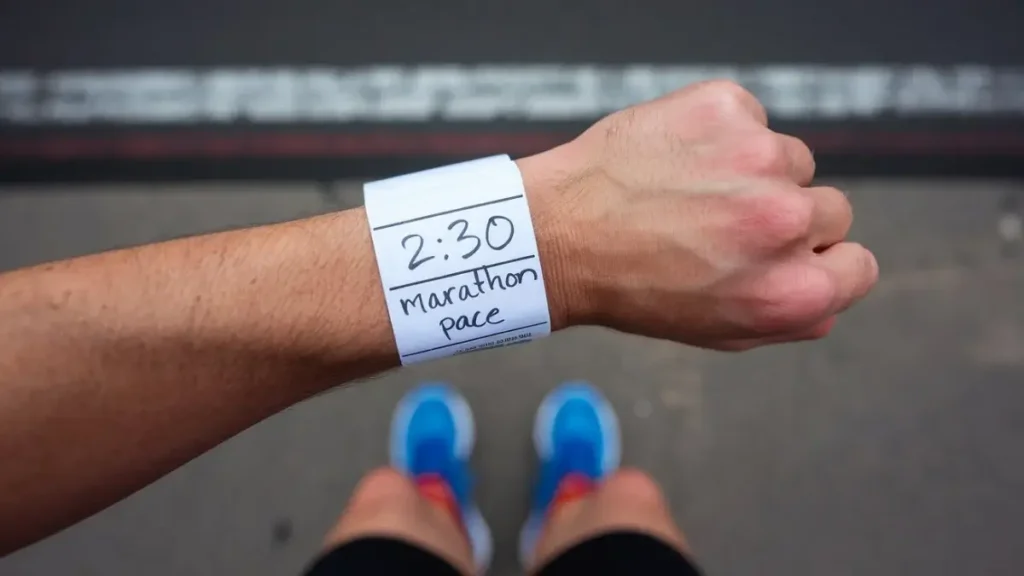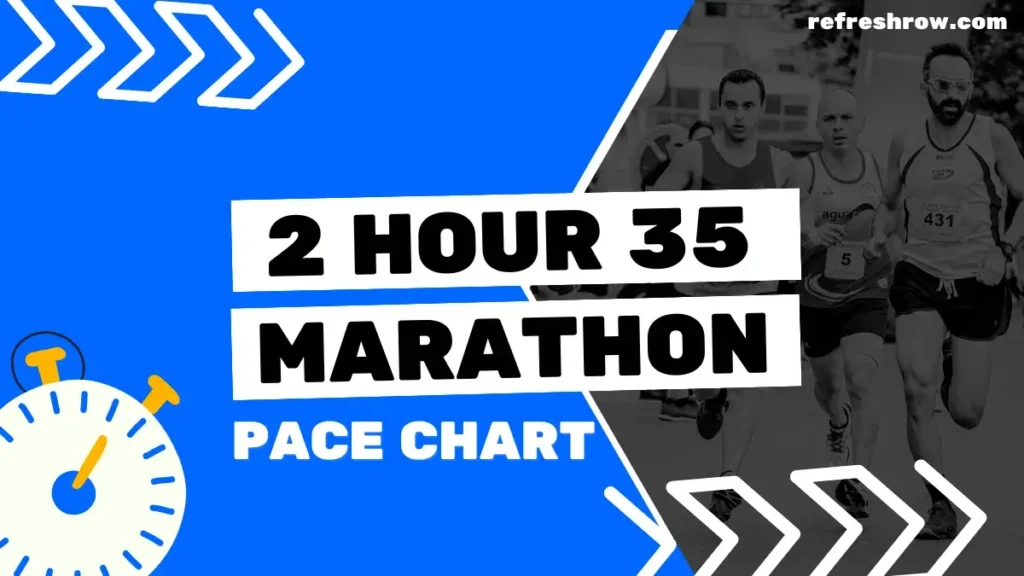To run a 3:00 hour marathon you need to run at a pace of 6:52 per mile or 4:16 per kilometer.
Following the splits below (and shaving off a second), you’ll run a sub 3:00 marathon.
I’d recommend aiming to run 1-2 minutes ahead of the split target time from 10 miles, as you’ll likely come up against crowding on race day.
3:00 Marathon Pace in Miles
| Mile | Split |
|---|---|
| 1 | 6:52 |
| 2 | 13:44 |
| 3 | 20:36 |
| 4 | 27:28 |
| 5 | 34:20 |
| 6 | 41:12 |
| 7 | 48:03 |
| 8 | 54:55 |
| 9 | 1:01:47 |
| 10 | 1:08:39 |
| 11 | 1:15:31 |
| 12 | 1:22:23 |
| 13 | 1:29:15 |
| 14 | 1:36:07 |
| 15 | 1:42:59 |
| 16 | 1:49:51 |
| 17 | 1:56:43 |
| 18 | 2:03:35 |
| 19 | 2:10:26 |
| 20 | 2:17:18 |
| 21 | 2:24:10 |
| 22 | 2:31:02 |
| 23 | 2:37:54 |
| 24 | 2:44:46 |
| 25 | 2:51:38 |
| 26 | 2:58:30 |
| 26.2 | 3:00:00 |
Download
3:00 Marathon Pace in KM
| KM | Split |
|---|---|
| 1 | 4:16 |
| 2 | 8:32 |
| 3 | 12:48 |
| 4 | 17:04 |
| 5 | 21:20 |
| 6 | 25:36 |
| 7 | 29:52 |
| 8 | 34:08 |
| 9 | 38:24 |
| 10 | 42:40 |
| 11 | 46:55 |
| 12 | 51:11 |
| 13 | 55:27 |
| 14 | 59:43 |
| 15 | 1:03:59 |
| 16 | 1:08:15 |
| 17 | 1:12:31 |
| 18 | 1:16:47 |
| 19 | 1:21:03 |
| 20 | 1:25:19 |
| 21 | 1:29:35 |
| 22 | 1:33:51 |
| 23 | 1:38:07 |
| 24 | 1:42:23 |
| 25 | 1:46:39 |
| 26 | 1:50:55 |
| 27 | 1:55:11 |
| 28 | 1:59:27 |
| 29 | 2:03:43 |
| 30 | 2:07:59 |
| 31 | 2:12:15 |
| 32 | 2:16:31 |
| 33 | 2:20:46 |
| 34 | 2:25:02 |
| 35 | 2:29:18 |
| 36 | 2:33:34 |
| 37 | 2:37:50 |
| 38 | 2:42:06 |
| 39 | 2:46:22 |
| 40 | 2:50:38 |
| 41 | 2:54:54 |
| 42 | 2:59:10 |
| 42.2 | 3:00:00 |
Download
Other Marathon Pace Charts
Targeting a different time?
Check out the Full Marathon Pace Chart in Miles or KM
Or select a specific finishing time below:
| 3:00 | 4:00 | 5:00 | |
| 3:05 | 4:05 | 5:15 | |
| 3:10 | 4:10 | 5:30 | |
| 3:15 | 4:15 | 5:45 | |
| 3:20 | 4:20 | 6:00 | |
| 3:25 | 4:25 | 6:15 | |
| 2:30 | 3:30 | 4:30 | 6:30 |
| 2:35 | 3:35 | 4:35 | 6:45 |
| 2:40 | 3:40 | 4:40 | 7:00 |
| 2:45 | 3:45 | 4:45 | |
| 2:50 | 3:50 | 4:50 | |
| 2:55 | 3:55 | 4:55 |
Training for a 3:00 Marathon
Is 3:00 a Good Marathon Time?
Well, what do the stats say?
Run Repeat conducted a study that contains 19,614,975 marathon results from more than 32,335 races across the globe, here is how a 3 hour marathon compares against age and gender for the races recorded:
| Overall | You’re faster than 98.1% of all runners. |
| Male | You’re faster than 97.0% of males. |
| Female | You’re faster than 99.5% of females. |
| <20 | You’re faster than 96.2% of under 20s. |
| 20-29 | You’re faster than 96.4% of 20-29 year olds. |
| 30-39 | You’re faster than 97.3% of 30-39 year olds. |
| 40-49 | You’re faster than 98.7% of 40-49 year olds. |
| 50-59 | You’re faster than 99.7% of 50-59 year olds. |
| >60 | You’re faster than 99.9% of over 60s. |
Training Runs and Paces for a 3:00 Marathon
To break a 3:00 marathon you’ll need to do some serious distance in your training, I recommend at least 35 miles (56km) per week.
You’re also going to need to make sure you’ve crossed off these milestones for other race distances:
- A 5k in 18:45 mins
- A 10k in 39:00 mins
- A half marathon in 1 hour 23 mins
Pace for Training
| Pace | Mins per Mile | Mins per KM |
|---|---|---|
| Easy | 7:44 | 4:48 |
| Steady | 6:52 | 4:15 |
| 10k | 6:17 | 3:54 |
| 5k | 6:02 | 3:45 |
| 1 Mile | 5:36 | 3:30 |
Weekly Mileage Targets
| Target Mileage: | Gradually increase your weekly mileage from 40 miles (64 km) to a peak of 68 miles (109 km). |
| Incremental Increase: | Increase mileage by approximately 10% each week, with every fourth week as a recovery week where mileage is reduced by 20-30%. Make sure to taper for the last 1-2 weeks. |
Long Run Structure
| Total Distance: | Build up to long runs of 20-22 miles (32-35 km). |
| Segment Example: | First 5 miles (8 km): Easy pace, heart rate 140-150 bpm (approximately 7:55/mile or 4:55/km). Next 1 mile (1.6 km): Fast pace at 5:50/mile (3:37/km). Next 5 miles (8 km): Medium effort, heart rate around 160 bpm (approximately 6:50/mile or 4:15/km). Repeat: Repeat the segment twice (5 miles easy, 1 mile fast, 5 miles medium), you can taper the final 2 miles if required. |
Why This Works: Incorporating varied paces within long runs enhances lactate tolerance, which helps on race day when you’ve got to maintain pace despite feeling fatigued. By practicing surges during a run, you can build up your physical and mental resilience (lots of elite marathon runners use these strategies during their training)
Alternating Long Runs: Alternate between structured long runs (easy/fast segments) and easier long runs. For easier long runs, maintain a steady, comfortable pace throughout, focusing on mileage rather than speed to aid recovery.
Speedwork Sessions
| Short Intervals: | – 800m repeats at 2:55 per interval (3:37/km). – Aim for 6-12 repetitions with equal time for recovery. |
| Mile Repeats: | – 1 mile repeats at 5:50 per mile (3:37/km). – Aim for 6-12 repetitions with a 1-2 minute recovery jog. |
| Longer Intervals: | – 2 mile repeats at 6:00 per mile (3:44/km). – Aim for 5-8 repetitions with a 2-3 minute recovery jog. |
Recovery and Rest Days
| Rest Days: | You don’t need to incorporate rest days if you are using recovery runs, but I recommend taking 1 (or a max of 2) per week to allow your body to recover and prevent overtraining. |
| Easy Run Days: | Include 1-2 easy run days per week at a relaxed pace of 8:30/mile (5:17/km), covering 5-10 miles (8-16 km) per day. Try to keep your heart rate below 140 bpm on easy days to ensure proper recovery and aerobic development. |
My Tips to Run a Sub 3:00 Marathon
1. Mental Conditioning
I’ve spoken a lot about how to make your body strong enough to achieve a 3-hour marathon, but you’ll also need to focus on the other side of the equation = your mind.
Building mental toughness so you can push through when it gets difficult plays a far bigger role than going for an extra run.
Fortunately, you can train your body and mind at the same time, by pushing yourself out of your comfort zone, and not giving up when the going gets tough.
2. Nutritional Optimization and Hydration Strategy
Proper nutrition and hydration also play a pivotal role in achieving a sub-3:00 marathon.
On race day, you need your nutrition plan to include simple carbohydrates, electrolytes, and hydration (with sodium) to help prevent energy dips and dehydration.
During training, experiment with different gels, drinks, and solid foods to determine what works best for you.
To help avoid getting funny tummy issues on race day, ensure your gut is accustomed to your chosen nutrition strategy.
3. Strength Training and Injury Prevention
Integrating strength training into your routine can improve your running economy and help prevent injuries.
Focus on core stability, leg strength, and flexibility exercises. I like to keep the exercise program simple and use resistance training like squats and lunges with core work like planks and dynamic stretches to enhance muscle endurance and joint stability.
Additionally, consider incorporating cross-training activities such as cycling or swimming if you feel your legs are getting overworked, to reduce the risk of overuse injuries.
4. Recovery Techniques and Sleep Optimization
Effective recovery strategies are really important for sustaining high-intensity training.
Lots of runners don’t like doing them as they’re painful/boring, but they are vital to make sure you can keep pressing on the gas.
Consider foam rolling, sports massages, and active recovery workouts to alleviate muscle soreness and promote blood flow.
Also, prioritize sleep, aiming for 7-9 hours per night, as it is critical for muscle repair and overall performance enhancement.
Use a fitness watch to track your sleep patterns and make adjustments to make sure you’re getting a good night’s rest, as this is when the body repairs itself.


Row Brown is the founder of Refresh Row. He is a keen marathon runner, his favorite being the London Marathon. He’s now set himself the mission of Running the Entire Length of Spain, which is scheduled for late 2024.


